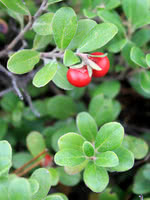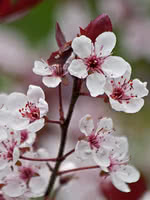Mon-Fri 9am - 5pm Mountain time
Bearberry vs Purple Leaf Sand Cherry
Arctostaphylos uva-ursi
Prunus x cistena
NOT AVAILABLE THIS SEASON - MIGHT RETURN
CUSTOM GROW
Bearberry is a dwarf shrub known for its creamy pink flowers and red edible fruits.
It is great as a filler in gardens and flowerbeds in place of invasive ground cover plants, like English Ivy.
Bearberry will attract hummingbirds, butterflies and bees to your property. It is one of the top 12 plants recommended by the Alberta Native Bee Council to support pollinators.
Purple Leaf Sand Cherry provides bright reddish-purple leaves that turn bronze-green in the fall. In the spring, tiny flowers with a pinkish white hue bloom. The flowers are small, but the impact comes from the shrub blossoming all at once.
The Purple leaf sand cherry can be susceptible to pests and diseases in more humid areas; a typical life span is approximately 15 years. Not suitable for a privacy hedge on its own but is often alternated with lilacs. Often used as an accent plant that attracts birds and bees.
Bearberry Quick Facts
Purple Leaf Sand Cherry Quick Facts
Toxicity: the leaves and seed are slightly toxic

